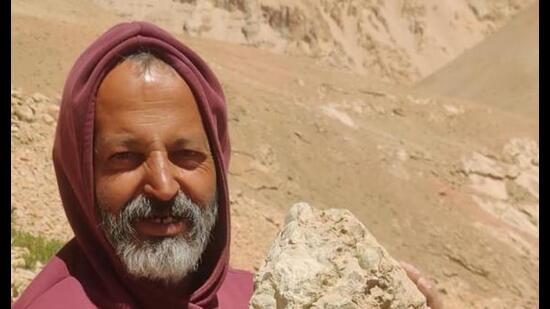Geologist finds marine fossils at icy heights in Ladakh
Ritesh Arya, founder of the Tethys Fossil Museum, says that he made the discovery while conducting groundwater exploration in the rugged terrains of Burtse in eastern Ladakh
A geologist has found a collection of marine (sea) fossils at an altitude of 16,000 feet above sea level further in Ladakh, augmenting the idea that Himalayas were born as continental plates thrust out of Tethys Sea about 40 million years ago.

Ritesh Arya, founder of the Tethys Fossil Museum, says that he made the discovery while conducting groundwater exploration in the rugged terrains of Burtse in eastern Ladakh.
Arya has “Unearthed an impressive collection” of marine fossils, including gastropods (snail-like mollusks), bivalves (shellfish) and foraminifera (mostly microscopic organisms).
These well-preserved fossils, which indicate a thriving marine environment at the time of deposition, are likely the first reported findings from this formation, a statement about the findings by the geologist said.
“The fossils offer a remarkable window into the past, allowing us to reconstruct the paleo environment of the region and enhance our understanding of the geological forces and interactions that shaped the planet, especially the birth Himalayas,” he said.
The geologist said that the discovery provides crucial data to unravel the mysteries of Earth’s history during the Eocene epoch, ranging from 56 to 33.9 million years — a time when the Tethys Sea is said to have spanned the region.
Preliminary investigations by the geologist suggest that the fossils morphologically resemble those of gastropods and foraminifera, similar to fossils found in the Subathu formation in Himachal Pradesh.
“They provide clear evidence of the existence of the Tethys Sea at that time—an intriguing revelation that connects India and Tibet through the waves of Tethys, showcasing a unique paleo-environmental connection,” the statement said.
The findings revealed that their presence at such heights highlights the immense tectonic forces that lifted these sediments from a near-coastal marine environment to these heights.
“The intricate folding and faulting of the region provide a glimpse into the magnitude of the geological forces that uplifted the diverse marine life that flourished millions of years ago, raising them to the heights where they are preserved today,” the statement added.
Kashmir University department of earth sciences head Bikram Singh said that the Indian continent broke away from the African continent millions of years ago. It came towards north through the Tethys Sea and slid under Eurasian plate, resulting in the formation of Himalayas.
“The floor of Tethys thrust up, that is why we find ophiolites (oceanic crust) in Ladakh. Those rocks contain marine fossils. These fossils have been found earlier as well in Ladakh, like the palm leaves,” Singh, who has done research on earthquakes, added.
“The discovery is not surprising. The marine animals of Tethys have been found at many places in Ladakh and Kashmir,” he added.






